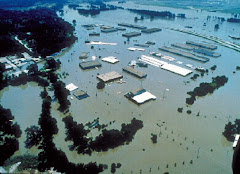
Polar Bears and Global Warming
By Michael Russell
Every year around December, about 200 to 250 female polar bears give birth to twins or triplets in the park area.
They are part of a population of about 1,200 polar bears in and around the park, some 600 miles north of Winnipeg in northern Manitoba.
The females fast during the first months with their cubs, but as spring approaches, they grab their cubs and make a run out onto the ice.
The females desperately need food by this time and much reach the Hudson Bay before the ice breaks up and the ringed seals, the favorite food of the Wapusk National Park polar bears, disappear.
It will take a family of polar bears about two to three weeks to make it to the ice, during which time each female will probably lose one or more her cubs. It's a tough journey.
Once the family reaches the ice, they'll feast on seals.
The mother will teach whatever number of cubs survive how to hunt for themselves.
If the cubs get through their first months outdoors, they'll spend the next two years by their mother's side, migrating to and from the Arctic ice packs and learning to hunt the seals.
Polar bears gorge themselves during the seven to eight months of the year when the ringed seal is available.
During that time they can triple their body weight.
Males may grow to 1,000 pounds or more during their feeding period while females may reach 600 pounds.
They'll need the extra weight to get them through the summer when the ice breaks up a=on the Hudson Bay and the polar bears move inland onto the summer tundra.
Polar bears are the world's largest land-based predator.
They have only one enemy, traditional Inuit natives who hunt the bear for their meat and fur.
But now they have another enemy - human-caused global warming.
Today, ice melts in the Hudson three weeks earlier in the spring than it did just 25 years ago.
The increasing sun and early ice melt means there is less time for the polar bears to fatten up for the summer months when they won't have access to the seals.
Polar bears amass most of their body fat during their spring feast of ringed seals.
When the ice disappears earlier, they aren't able to put on as much fat.
That fat is critical for the males, but even more critical for the females who must fast an additional period while they nurse their cubs.
Females lose an enormous amount of weight giving birth and caring for their cubs, but gain it back if they have enough time on the ice.
One female weighed only 250 pounds after her pup's birth, but ballooned to 880 the next year.
But scientists have noted a 10 percent drop in the number of cubs born in the last 20 years.
Adult bears are also 10 percent thinner.
At a lower body weight, females have a tougher time nursing, which is part of the reason there are fewer cubs.
Female polar bears use snow dens to give birth to their cubs.
But rising temperatures can affect these dens themselves.
If the dens melt early, the cubs are exposed to the outside world too soon.
The same is also true for the ringed seals, which are the prey of the polar bears.
They use snow dens to shelter their young.
Without the snow dens the health of both predator and prey are affected.


2 comments:
Since my favorite animal is the polar bear, I am truly ashamed due to the fact of the global warming, I hate green house even more than Generic Viagra . I think we must do something about this environmental nasty mess.
This is so sad that the polar bears are badly affecting by this climate change. One of the reason of melting these cold region is human technology advancement. Due to which there are many natural calamities are taking place worldwide.
Polar bears and global warming
Post a Comment